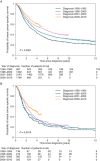Survival of women with inflammatory breast cancer: a large population-based study
- PMID: 24669011
- PMCID: PMC4432376
- DOI: 10.1093/annonc/mdu121
Survival of women with inflammatory breast cancer: a large population-based study
Abstract
Background: Our group has previously reported that women with inflammatory breast cancer (IBC) continue to have worse outcome compared with those with non-IBC. We undertook this population-based study to see if there have been improvements in survival among women with stage III IBC, over time.
Patient and methods: We searched the Surveillance, Epidemiology and End Results Registry to identify female patients diagnosed with stage III IBC between 1990 and 2010. Patients were divided into four groups according to year of diagnosis: 1990-1995, 1996-2000, 2001-2005, and 2006-2010. Breast cancer-specific survival (BCSS) was estimated using the Kaplan-Meier method and compared across groups using the log-rank test. Cox models were then fit to determine the association of year of diagnosis and BCSS after adjusting for patient and tumor characteristics.
Results: A total of 7679 patients with IBC were identified of whom 1084 patients (14.1%) were diagnosed between 1990 and 1995, 1614 patients (21.0%) between 1996 and 2000, 2683 patients (34.9%) between 2001 and 2005, and 2298 patients (29.9%) between 2006 and 2010. The 2-year BCSS for the whole cohort was 71%. Two-year BCSS were 62%, 67%, 72%, and 76% for patients diagnosed between 1990-1995, 1996-2000, 2001-2005, and 2006-2010, respectively (P < 0.0001). In the multivariable analysis, increasing year of diagnosis (modeled as a continuous variable) was associated with decreasing risks of death from breast cancer (HR = 0.98, 95% confidence interval 0.97-0.99, P < 0.0001).
Conclusion: There has been a significant improvement in survival of patients diagnosed with IBC over a two-decade time span in this large population-based study. This suggests that therapeutic strategies researched and evolved in the context of non-IBC have also had a positive impact in women with IBC.
Keywords: inflammatory breast cancer; stage III; survival; time trends.
© The Author 2014. Published by Oxford University Press on behalf of the European Society for Medical Oncology. All rights reserved. For permissions, please email: journals.permissions@oup.com.
Figures



References
-
- Early Breast Cancer Trialists’ Collaborative Group. Effects of chemotherapy and hormonal therapy for early breast cancer on recurrence and 15-year survival: an overview of the randomized trials. Lancet. 2005;00:1687–1717. - PubMed
-
- Henderson IC, Berry DA, Demetri GD, et al. Improved outcomes from adding sequential paclitaxel but not from escalating doxorubicin dose in an adjuvant chemotherapy regimen for patients with node-positive primary breast cancer. J Clin Oncol. 2003;21:976–983. - PubMed
-
- Mamounas EP, Bryant J, Lembersky B, et al. Paclitaxel after doxorubicin plus cyclophosphamide as adjuvant chemotherapy for node-positive breast cancer: results from NSABP B-28. J Clin Oncol. 2005;23:3686–3696. - PubMed
-
- Gianni L, Dafni U, Gelber RD, et al. Treatment with trastuzumab for 1 year after adjuvant chemotherapy in patients with HER2-positive early breast cancer: a 4-year follow-up of a randomised controlled trial. Lancet Oncol. 2011;12(3):236–244. - PubMed
MeSH terms
Grants and funding
LinkOut - more resources
Full Text Sources
Other Literature Sources
Medical

